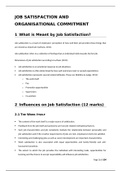JOB SATISFACTION AND
ORGANISATIONAL COMMITMENT
1 What is Meant by Job Satisfaction?
Job satisfaction is a result of employees’ perception of how well their job provides those things that
are viewed as important (Luthans, 2011).
Job satisfaction refers to a collection of feelings that an individual holds towards his/her job.
Dimensions of job satisfaction according to Luthans (2011):
Job satisfaction is an emotional response to job situations.
Job satisfaction is often determined by how well outcomes meet or exceed expectations.
Job satisfaction represents several related attitudes. These are (Robbins & Judge, 2013):
o The work itself
o Pay
o Promotion opportunities
o Supervision
o Co-workers
2 Influences on Job Satisfaction (12 marks)
2.1 THE WORK ITSELF
The content of the work itself is a major source of satisfaction.
Feedback from the job itself and autonomy are two job-related motivational factors.
Such job characteristics and job complexity mediate the relationship between personality and
job satisfaction and if the creative requirements of jobs are met, employees tend to be satisfied.
Interesting and challenging jobs as well as career development are important characteristics.
Work satisfaction is also associated with equal opportunities and family-friendly and anti-
harassment practices.
The extent to which the job provides the individual with interesting tasks, opportunities for
learning and the chance to accept responsibility will influence job satisfaction.
Page 1 of 104
,2.2 PAY
Wages and salaries are a significant factor in job satisfaction.
Money not only helps people attain their basic needs but is also instrumental in providing upper-
level need satisfaction.
Fringe benefits are also important, but not as influential.
Satisfaction can be increased by allowing some flexibility in choosing the type of benefits
preferred within a total package (flexible or cafeteria benefits plans).
The amount of remuneration and the degree to which this is viewed as equitable will influence
satisfaction.
2.3 PROMOTIONS
Promotional opportunities influence job satisfaction.
These opportunities take several different forms and reward.
Individuals promoted based on seniority often experience job satisfaction but not as much as
those promoted based on performance.
Executive promotions may be more satisfying than promotions at lower levels of the
organisation.
With the flattening of organisations, a positive work environment and opportunities to grow and
broaden their skills base have become for many more important than promotion opportunities.
2.4 SUPERVISION
Two dimensions of supervisory styles affect job satisfaction.
One is employee centredness, which is measured by the degree to which a supervisor takes a
personal interest in and cares about the employee.
The other dimension is participation or influence, which allows employees to participate in
decisions that affect their jobs.
The participate climate leads to higher job satisfaction.
2.5 WORK GROUP
The nature of the team will have an effect on job satisfaction.
Friendly, cooperative co-workers are a modest source of job satisfaction.
The work group serves as a source of support, comfort, advice and assistance to the members.
Page 2 of 104
, Groups require considerable interdependence among members to get the job done will have
higher satisfaction.
A good work group makes the job more enjoyable.
If the reverse conditions exist, this may have a negative effect on job satisfaction.
If members are resistant to teams in general, they will be less satisfied than if they welcome
being part of the teams.
2.6 WORKING CONDITIONS
If the working conditions are good, employees will find it easier to carry out their jobs.
If conditions are poor, employees will find it more difficult to get things done.
The effect of working conditions on job satisfaction is like that of the work group.
Organisations are trying to make conditions more supportive and non-discriminatory.
3 Outcomes of Job Satisfaction (9 marks)
(Robbins & Judge, 2013)
3.1 SATISFACTION AND PERFORMANCE
Research to date has been mixed. About 36 years ago, studies indicated a weak relationship
(Iffaldano & Muchinsky, 1985). However, recent studies show a much stronger relationship
between job satisfaction and performance.
The best conclusion is that there is a positive relationship. Although there is recent, supporting
research evidence on the casual direction, showing satisfaction influences performance rather
than vice versa, the relationship may even be more complexed than others are.
3.2 SATISFACTION AND TURNOVER
Research has under covered a moderately inverse relationship between satisfaction and
turnover.
High job satisfaction will not in itself keep turnover low, but it does seem to help.
On the other hand, if there is considerable job satisfaction, there is likely to be high turnover.
Obviously, other variables enter into an employee’s decision to quite besides job satisfaction.
Overall, it is accurate to say that job satisfaction is important in employee turnover.
Page 3 of 104
, 3.3 SATISFACTION AND ABSENTEEISM
Research has only demonstrated a weak negative relationship between satisfaction and
absenteeism.
As with turnover, many other variables enter into the decision to stay home besides satisfaction
with the job.
It is important to remember that although high job satisfaction will not necessarily result in low
absenteeism, low job satisfaction is more likely to bring about absenteeism.
4 Guidelines to enhance job satisfaction
4.1 Make jobs more fun
Having a fun culture may not make jobs themselves more satisfying, bit it does break up
boredom and lessen the chances of dissatisfaction.
4.2 Have fair pay, benefits and promotion opportunities
One way to make benefits more effective would be to provide a flexible, so-called cafeteria
approach.
This allows employees to choose their own distribution of benefits within the budgeted
amount available.
This way there would be no discrepancies between what they want, because it is their
choice.
4.3 Match people with jobs that fit interest and skills
Organisations should be considerable effort into finding out the interests and skills of
potential new employees, as well as existing employees, in order to make the match or fit
with the right job.
4.4 Design jobs to make them exciting and satisfying
This approach suggests designing jobs to fit the people, as most people do not find boring,
repetitive work very satisfying.
Page 4 of 104




